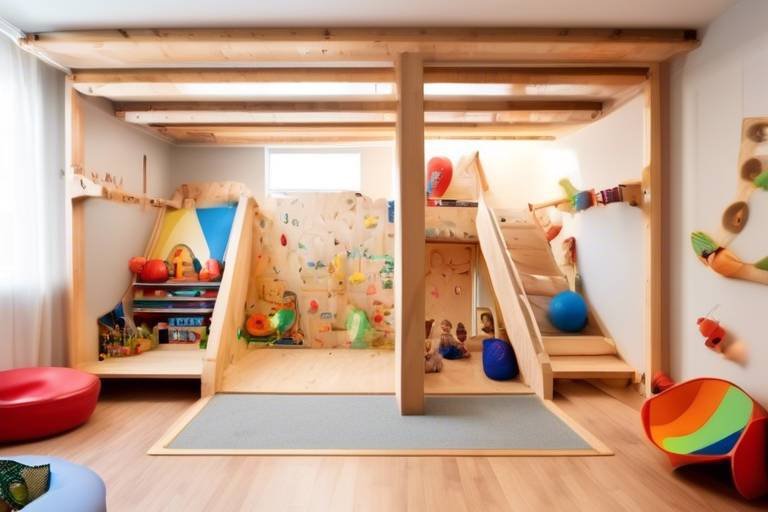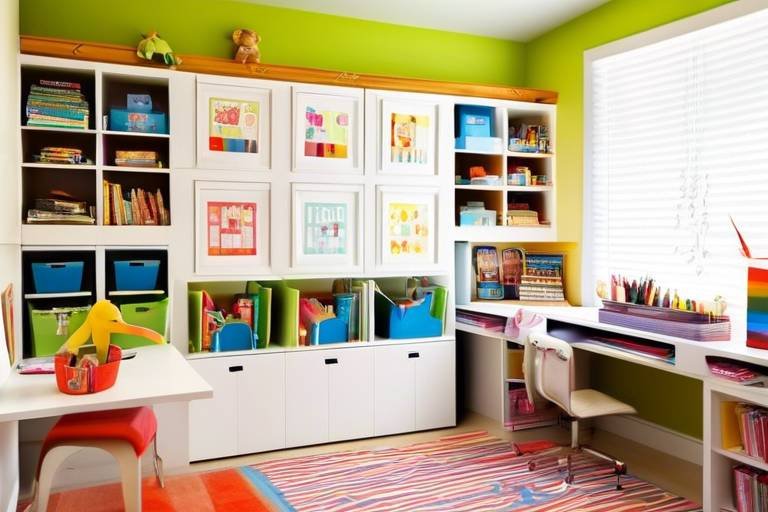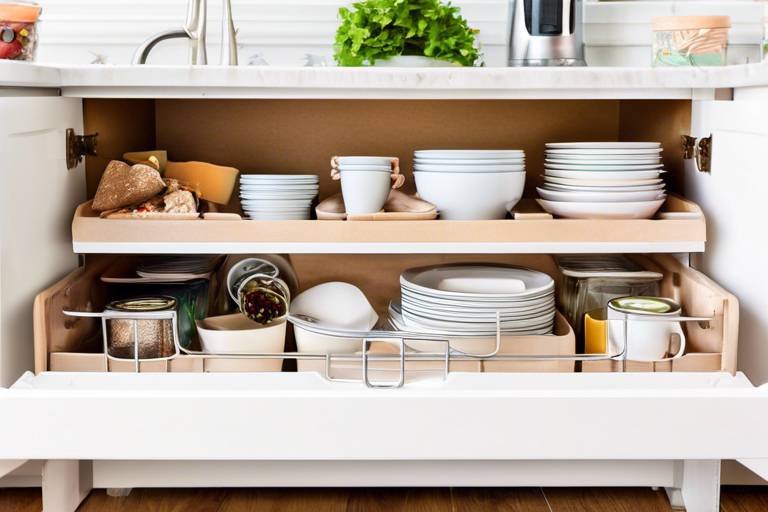5 Rules for a Well-Functioning Family Kitchen
Creating a harmonious and efficient family kitchen is essential for turning cooking and meal preparation into enjoyable experiences for everyone involved. Think of your kitchen as the heart of your home, a place where flavors mingle and memories are made. By following some simple yet effective rules, you can transform this space into a vibrant hub of activity that brings your family together. Let’s dive into these five essential rules that will revolutionize your kitchen experience.
Defining roles within the kitchen is like setting the stage for a fantastic performance. When each family member knows their responsibilities, it streamlines tasks and fosters teamwork. Imagine cooking as a dance—everyone has their part to play. For instance, one person could handle chopping vegetables while another stirs the pot. This not only makes the cooking process smoother but also allows everyone to contribute effectively. By working together, you’ll create delicious meals and strengthen family bonds at the same time!
A clean kitchen promotes safety and efficiency. Picture this: you walk into a cluttered kitchen with dishes piled high, and ingredients scattered everywhere. It’s overwhelming, right? Regularly cleaning and organizing your workspace can significantly enhance the cooking experience. Set aside a few minutes after each meal to tidy up. This habit not only keeps your kitchen looking great but also encourages family members to join in. After all, who wants to cook in chaos? A clean kitchen can make cooking feel like a delightful adventure rather than a daunting task.
Involving the whole family in meal planning is a game-changer! Not only does it encourage healthy eating habits, but it also makes everyone feel included and invested in the cooking process. Imagine sitting around the table, brainstorming ideas for the week’s meals. You could create a colorful chart or a simple list of options, allowing everyone to contribute their favorite dishes. This collaborative effort can lead to exciting culinary discoveries and ensures that everyone looks forward to mealtime. Plus, who doesn’t love a little family brainstorming session over snacks?
Open communication about preferences, dietary restrictions, and cooking techniques fosters a supportive environment. It’s essential for family members to express their thoughts and collaborate effectively in the kitchen. For example, if someone dislikes a particular ingredient, it’s better to know ahead of time than to find out at the dinner table! Consider having a weekly family chat about what everyone would like to eat and any new recipes they want to try. This way, everyone feels heard, and you can create meals that everyone will enjoy.
Having the right kitchen tools and appliances can make cooking easier and more enjoyable. Think of cooking as a craft; having the right tools is like an artist having their brushes. Investing in quality equipment not only enhances efficiency but also encourages family members to explore their culinary skills. Consider creating a wishlist together as a family. You might discover that a new blender or a set of good knives can inspire everyone to get creative in the kitchen!
Establishing a routine for cooking can help family members anticipate their kitchen responsibilities. It’s like having a family calendar but for meals! By setting specific days for cooking, everyone knows when it’s their turn to shine in the kitchen. This not only makes it easier to plan meals but also ensures that everyone contributes to the cooking process. Think of it as a team sport—everyone has a role, and together, you create a delicious outcome!
Incorporating fun elements into cooking can transform meal preparation into an enjoyable family bonding activity. Consider hosting themed cooking nights or friendly cooking challenges. For example, you could have a taco night where everyone builds their own tacos or a bake-off to see who can create the best dessert. These activities foster creativity and teamwork while making cooking a memorable experience for everyone involved.
Cooking with family requires a good dose of patience and adaptability. Things may not always go as planned—maybe the recipe doesn’t turn out right, or someone burns the bread. Instead of getting frustrated, embrace these moments as learning experiences. Maintaining a positive atmosphere encourages everyone to experiment and learn from their mistakes. Remember, the goal is to enjoy the process together!
Recognizing and celebrating individual contributions and successes in the kitchen fosters a sense of accomplishment. Whether it’s mastering a new recipe or simply helping out with dinner, take the time to acknowledge everyone’s efforts. You could even create a “Chef of the Week” award to highlight outstanding contributions. Celebrating these moments encourages family members to continue exploring their culinary passions together.
- How can I get my kids involved in cooking?
Start with simple tasks, like washing vegetables or stirring ingredients. Gradually introduce them to more complex tasks as they gain confidence. - What if my family has different dietary restrictions?
Plan meals that can be easily customized, allowing everyone to add or omit ingredients based on their preferences. - How often should we clean the kitchen?
Aim for a quick clean after each meal and a deeper clean weekly to maintain a tidy environment.

Establish Clear Roles
When it comes to creating a harmonious family kitchen, one of the most effective strategies is to for each family member. Think of your kitchen as a well-orchestrated symphony; every musician (or in this case, family member) has a specific part to play. By defining these roles, you can streamline tasks and responsibilities, making the cooking process smoother and more enjoyable for everyone involved.
Imagine the chaos that could ensue if everyone tried to chop vegetables, stir sauces, and set the table all at once! Instead, having designated roles not only enhances efficiency but also fosters a sense of teamwork and cooperation. For instance, one person could be in charge of meal prep, while another handles cooking, and yet another manages cleanup. This division of labor allows each family member to focus on their task, ultimately leading to a more organized and productive kitchen environment.
To make this process even more effective, consider holding a family meeting to discuss and assign roles based on each person's strengths and preferences. Some family members might love the idea of being the head chef, while others might prefer to be the sous chef or the cleaning crew. Here’s a simple table to illustrate potential roles:
| Role | Responsibilities |
|---|---|
| Head Chef | Oversees meal preparation and cooking. |
| Sous Chef | Assists with chopping, mixing, and ingredient preparation. |
| Server | Sets the table and serves meals. |
| Cleanup Crew | Washes dishes and cleans the kitchen after meals. |
By assigning these roles, you create a sense of accountability and ownership, allowing each family member to contribute meaningfully to the cooking process. This not only helps to reduce stress during meal times but also encourages everyone to communicate better and support each other. Plus, when everyone knows their responsibilities, it can turn cooking into a fun and collaborative family activity rather than a chore.
So, next time you step into the kitchen, remember that clear roles can transform the way your family cooks together. It’s all about creating a system that works for you, making the kitchen a place of joy and shared experiences. After all, cooking is not just about the food; it’s about the moments you create together.

Maintain a Clean Workspace
When it comes to cooking, maintaining a clean workspace is not just about aesthetics; it's a crucial aspect of food safety and efficiency. Imagine stepping into a kitchen where every surface gleams and every utensil is in its rightful place. It’s like walking into a well-organized workshop, where creativity flows freely without the hindrance of clutter. A clean kitchen not only enhances your cooking experience but also encourages family members to join in the fun. After all, who wants to whip up a delicious meal in a chaotic environment?
To keep your kitchen spick and span, start by implementing a simple cleaning routine. This can include wiping down surfaces before and after cooking, as well as regularly washing dishes and utensils. Think of it as a dance: you chop, you stir, and you clean in between. This rhythm not only keeps the workspace tidy but also minimizes the risk of cross-contamination, ensuring that your family enjoys safe and healthy meals.
Furthermore, consider organizing your kitchen tools and ingredients in a way that promotes efficiency. For instance, you could use clear containers for dry goods, making it easy to see what you have on hand. A well-organized pantry can save you time and reduce stress during meal prep. Here’s a quick table to illustrate some effective organization tips:
| Organization Tip | Description |
|---|---|
| Label Containers | Use labels on jars and containers to easily identify ingredients. |
| Group Similar Items | Keep spices, oils, and baking supplies together for easy access. |
| Utilize Vertical Space | Install shelves or hooks to maximize storage and keep surfaces clear. |
In addition to these tips, it’s essential to involve the whole family in the cleaning process. Make it a fun activity! Play some music, set a timer, and see how quickly everyone can tidy up. This not only teaches responsibility but also reinforces the idea that a clean kitchen is a shared space that requires collective effort. When everyone pitches in, it fosters a sense of ownership and pride in your family kitchen.
Lastly, remember that maintaining a clean workspace goes beyond just physical cleanliness. It’s also about creating a positive atmosphere. Encourage family members to express their thoughts about the kitchen setup and cleanliness. Open discussions can lead to better organization strategies and a more enjoyable cooking environment. After all, a clean kitchen is not just a place for cooking; it’s the heart of family life, where memories are made and meals are shared.
- How often should I clean my kitchen? It's best to clean your kitchen after every use, but a deep clean should be done weekly.
- What are some quick cleaning tips? Wipe down surfaces, wash dishes immediately, and declutter as you cook.
- How can I get my family involved in cleaning? Turn it into a game or set a cleaning schedule to make it a fun family activity.

Plan Meals Together
When it comes to creating a family kitchen that runs smoothly, one of the most rewarding practices is to involve the whole family in meal planning. Not only does this approach promote healthier eating habits, but it also fosters a sense of inclusion and teamwork. Imagine sitting around the table, brainstorming ideas for the week’s meals, where everyone has a say. It’s like a mini-adventure where each family member can contribute their favorite dishes or try something new!
Meal planning together can be a delightful way to bond as a family. You might find that your kids are more excited to eat their vegetables if they had a hand in choosing how they’re prepared. Plus, it helps to eliminate the dreaded “What’s for dinner?” question that often leads to last-minute takeout. When everyone has a role in the planning, you create a shared responsibility that makes cooking feel less like a chore and more like a collaborative project.
To make the meal planning process even more effective, consider creating a simple chart or table to organize your ideas. Here’s a quick example of how you might structure your meal planning:
| Day | Meal | Who’s Cooking? |
|---|---|---|
| Monday | Spaghetti and Meatballs | Dad |
| Tuesday | Taco Night | Mom |
| Wednesday | Grilled Chicken Salad | Kids |
| Thursday | Stir-Fry | Whole Family |
| Friday | Pizza Night | Family Fun Night |
This table not only keeps everyone informed but also assigns cooking responsibilities, making the process feel more organized. Plus, it can be a fun challenge for the kids to come up with creative meal ideas for their assigned days! Encourage them to explore different cuisines or even try their hand at baking. The possibilities are endless, and each meal becomes an opportunity for learning and growth.
Moreover, planning meals together can also serve as a great way to teach kids about nutrition, budgeting, and time management. Discussing ingredients and recipes can spark their interest in cooking and help them develop essential life skills. You might even find that they become more adventurous eaters, willing to try new things because they had a hand in the planning process.
In conclusion, meal planning as a family is not just about deciding what to eat; it's about creating memories, encouraging healthy habits, and building a nurturing kitchen environment. So gather your family, pull out those recipe books, and start planning your next culinary adventure together!
- How often should we plan meals together? Ideally, you should plan meals weekly, so everyone knows what to expect and can prepare accordingly.
- What if we can’t agree on a meal? Consider taking turns choosing meals or using a voting system to decide on options.
- Can meal planning really save us money? Yes! Planning meals helps reduce impulse buys and minimizes food waste.
- How can we make meal planning more fun? Incorporate themes, like “Meatless Monday” or “Throwback Thursday,” to keep things exciting!

Encourage Open Communication
When it comes to a family kitchen, communication is the key. Imagine trying to cook a delicious meal without knowing what everyone likes or dislikes. It would be like trying to solve a puzzle with missing pieces! Encouraging open communication in the kitchen allows family members to share their preferences, dietary restrictions, and even cooking techniques. This not only creates a supportive atmosphere but also ensures that everyone feels heard and valued.
Have you ever experienced a situation where someone made a meal that nobody wanted to eat? That’s where open dialogue comes into play. By discussing meal choices and cooking methods openly, families can avoid these awkward situations. For instance, if someone has a gluten intolerance, it’s crucial for the rest of the family to know so they can adjust their cooking accordingly. Regular family meetings or casual kitchen chats can be an excellent way to bring everyone together to discuss what’s on the menu for the week.
Moreover, encouraging family members to share their cooking experiences can lead to exciting culinary discoveries. Perhaps one family member has a secret ingredient that transforms a regular dish into something extraordinary. By sharing these little nuggets of wisdom, the kitchen becomes a place of collaboration and creativity. Consider implementing a “recipe of the week” where each family member can present a dish they love, followed by a discussion on how to make it together. This not only enhances cooking skills but also strengthens family bonds.
It's also essential to create a safe space for feedback. When cooking together, it’s easy to get caught up in the heat of the moment, but constructive criticism can help improve everyone’s culinary skills. Instead of saying, “This is terrible,” encourage family members to express their thoughts in a more positive light, like “I think it would taste even better with a pinch of salt.” This approach fosters an environment where everyone feels comfortable sharing their opinions and learning from one another.
To summarize, open communication in the kitchen can transform meal preparation from a mundane task into a delightful family activity. By discussing preferences, sharing cooking tips, and providing constructive feedback, families can create an inclusive and enjoyable cooking experience. Remember, the kitchen is not just a place for cooking; it's a space for connection, creativity, and collaboration!
- How can we improve communication in the kitchen? Start by having regular family discussions about meal preferences and cooking experiences. Encourage everyone to share their thoughts and ideas.
- What if someone has dietary restrictions? Make it a point to discuss dietary needs openly, so everyone is aware and can adjust their cooking accordingly.
- How can we make cooking together more enjoyable? Incorporate fun elements like themed cooking nights or cooking challenges to keep everyone engaged and excited.

Invest in Quality Tools
This article discusses essential guidelines to create a harmonious and efficient family kitchen, ensuring that cooking and meal preparation become enjoyable experiences for everyone involved.
Defining roles within the kitchen helps streamline tasks and responsibilities, allowing family members to contribute effectively while fostering teamwork and cooperation during meal preparation.
A clean kitchen promotes safety and efficiency. Regularly cleaning and organizing your workspace can significantly enhance the cooking experience and encourage family members to participate.
Involving the whole family in meal planning not only encourages healthy eating habits but also makes everyone feel included and invested in the cooking process.
Open communication about preferences, dietary restrictions, and cooking techniques fosters a supportive environment, enabling family members to express their thoughts and collaborate more effectively in the kitchen.
When it comes to creating a functional family kitchen, one of the most important aspects is to . Imagine trying to build a house with only a hammer; it would be challenging, right? The same principle applies to cooking. Having the right tools can transform the cooking experience from a chore into a delightful adventure. Quality kitchen tools not only enhance efficiency but also inspire creativity, making everyone in the family eager to participate.
Consider the difference between using a dull knife and a sharp one. A sharp knife makes chopping vegetables a breeze, while a dull knife can turn the task into a frustrating ordeal. Investing in quality knives, pots, pans, and other essential tools can significantly improve the overall cooking experience. Here are some categories of tools to consider:
- Knives: A good chef's knife is essential for any kitchen. Look for one that feels comfortable in your hand and has a sturdy blade.
- Pots and Pans: Invest in a few high-quality pots and pans that can handle various cooking methods, from frying to simmering.
- Utensils: Quality spatulas, ladles, and spoons can make a big difference in how smoothly your cooking process goes.
- Appliances: Consider adding appliances like a blender, food processor, or slow cooker to your collection. These can save time and open up new cooking possibilities.
Moreover, investing in quality tools can lead to long-term savings. While the initial cost may be higher, durable tools will last longer and often perform better than cheaper alternatives. Think of it as a wise investment in your family's culinary journey. Plus, having the right tools can spark a sense of pride and ownership among family members. When everyone feels equipped to cook, they are more likely to get involved and try new recipes.
In summary, investing in quality kitchen tools is not just about having the latest gadgets; it’s about creating an environment where cooking becomes a shared joy rather than a burdensome task. So, take a moment to evaluate your kitchen tools, and consider upgrading where necessary. You'll be amazed at how much more fun cooking can be when you're equipped with the right gear!
Establishing a routine for cooking can help family members anticipate their kitchen responsibilities, making it easier to plan meals and ensuring everyone contributes to the cooking process.
Incorporating fun elements into cooking, such as themed nights or cooking challenges, can transform meal preparation into an enjoyable family bonding activity, fostering creativity and teamwork.
Cooking with family requires patience and adaptability. Understanding that things may not always go as planned can help maintain a positive atmosphere and encourage everyone to learn from mistakes.
Recognizing and celebrating individual contributions and successes in the kitchen fosters a sense of accomplishment and encourages family members to continue exploring their culinary passions together.
Q: What are some essential tools for a family kitchen?
A: Essential tools include a good chef's knife, quality pots and pans, various utensils, and useful appliances like a blender or food processor.
Q: How can I encourage my kids to help in the kitchen?
A: Involve them in meal planning, assign them age-appropriate tasks, and make cooking a fun and engaging activity.
Q: What is the best way to clean kitchen tools?
A: Regularly wash tools with warm soapy water, and for knives, ensure they are dried immediately to prevent rust.

Set a Regular Cooking Schedule
Establishing a regular cooking schedule can be a game changer for any family. Think of it as creating a rhythm in your household, much like a favorite song that everyone can dance to. When everyone knows when it’s their turn to cook, it not only eases the chaos but also fosters a sense of responsibility and teamwork. Imagine walking into your kitchen and knowing exactly what’s on the menu for the week—no more last-minute scrambling or takeout runs!
To get started, consider creating a simple weekly calendar that outlines who cooks on which days. You can use a whiteboard in the kitchen, a shared digital calendar, or even a piece of paper stuck to the fridge. Here’s a quick example of what that might look like:
| Day | Family Member | Meal |
|---|---|---|
| Monday | Mom | Spaghetti |
| Tuesday | Dad | Taco Night |
| Wednesday | Son | Grilled Cheese & Soup |
| Thursday | Daughter | Stir Fry |
| Friday | Family Night | Pizza |
This simple visual can help everyone stay on the same page and ensure that meal preparation is shared equally. Moreover, it encourages family members to get creative with their cooking. They can experiment with new recipes, try different cuisines, or even have themed nights that everyone looks forward to.
But let’s be real; life can be unpredictable! That’s why it’s crucial to maintain a level of flexibility within your cooking schedule. If someone has a last-minute commitment or just isn’t feeling up to cooking, it’s perfectly fine to swap days or even have a designated “leftover night.” This adaptability not only keeps the peace but also teaches everyone the importance of compromise and teamwork.
Additionally, having a regular cooking schedule can help in meal planning, which is a fantastic way to promote healthier eating habits. When you know what you’re cooking ahead of time, you can make better grocery lists, save money, and reduce food waste. Plus, it allows you to incorporate more fresh ingredients into your meals, which is always a win for the family’s health.
So, why not give it a shot? Sit down as a family and create your cooking schedule together. Not only will it make meal times easier, but it will also turn cooking into a delightful bonding experience. After all, the kitchen is often the heart of the home, and a well-organized cooking routine can only make it beat stronger!
- How do I get my family members to participate in cooking? Start by assigning simple tasks based on their abilities and interests, and gradually increase their responsibilities as they become more comfortable in the kitchen.
- What if someone doesn’t like cooking? Encourage them to take on other roles, such as meal planning or setting the table, to keep them involved without the pressure of cooking.
- How can I make cooking more fun for kids? Involve them in the process by letting them choose recipes, decorate the table, or even have themed cooking nights where everyone dresses up related to the cuisine.

Make Cooking Fun
Cooking can sometimes feel like a chore, especially after a long day. However, it doesn't have to be that way! Transforming meal preparation into a fun and engaging experience can make all the difference for your family. Think of the kitchen as a playground where creativity flows and laughter echoes. So, how can you sprinkle some joy into your cooking routine? Here are a few ideas to get you started!
First off, consider introducing themed cooking nights. Imagine a taco Tuesday where everyone gets to assemble their own taco creations. You can lay out a buffet of toppings and let each family member customize their meal according to their preferences. This not only makes cooking interactive but also allows everyone to express their culinary creativity. You could even have a pizza night where everyone crafts their own personal pizza from scratch! Who doesn’t love a good pizza party?
Another way to make cooking enjoyable is by turning it into a friendly competition. You could host a family cook-off where each member is tasked with creating a dish using a specific ingredient. Set a timer, and when the time is up, everyone gets to taste and vote for their favorite dish! This not only encourages creativity but also fosters a sense of teamwork and collaboration. Plus, it’s a great way to discover hidden culinary talents within your family!
Don’t forget to add a little music to your cooking sessions! Playing upbeat tunes can lift the mood and energize everyone in the kitchen. Dancing while chopping vegetables or singing along while stirring the pot can turn an ordinary cooking session into a mini party. Just imagine the joy of cooking together while your favorite songs play in the background – it’s hard not to have fun!
Lastly, consider incorporating cooking challenges or cooking classes into your routine. Whether it’s learning a new cuisine or mastering a complex dish, these activities can be both educational and entertaining. You might even want to invite friends or relatives over for a cooking class, creating a social event around the culinary experience. Sharing the kitchen with others can lead to laughter, learning, and lasting memories.
In conclusion, making cooking fun is all about creativity and connection. By embracing themed nights, competitions, music, and learning opportunities, you can turn the kitchen into a vibrant space where everyone looks forward to gathering. So, gather your family, roll up your sleeves, and let the culinary adventures begin!
- How can I involve young children in cooking? Start with simple tasks like washing vegetables, stirring, or decorating dishes. Make it playful and let them experiment.
- What are some easy theme ideas for cooking nights? Taco Tuesdays, Italian Fridays, or Breakfast for Dinner are all fun options!
- How do I encourage picky eaters to participate? Allow them to choose ingredients for their dishes or let them be involved in the cooking process to increase their interest in trying new foods.

Practice Patience and Flexibility
Cooking with family can be a delightful yet unpredictable adventure. Just like a roller coaster, there are thrilling highs and unexpected twists that can leave you feeling exhilarated or a bit dizzy. This is why practicing patience and flexibility in the kitchen is essential. Imagine you’re in the middle of preparing a meal, and suddenly, a family member spills flour everywhere or forgets to pick up the ingredients you needed. Instead of letting frustration take over, take a deep breath, laugh it off, and remember that these moments often create the best memories.
Being patient means understanding that not everyone has the same cooking skills or speed. Some family members may be novice cooks, while others might be seasoned pros. Embrace the learning curve! For example, if your child is trying to chop vegetables for the first time, offer gentle guidance instead of rushing them. This not only helps them learn but also builds their confidence in the kitchen. You can think of it like teaching someone to ride a bike; it takes time and practice, but the joy of mastering it is worth every wobble and fall.
Flexibility is equally important. Sometimes, the recipe you planned might not go as expected. Perhaps you’re missing a crucial ingredient, or the oven decides to play tricks on you. Instead of letting these hiccups ruin your cooking experience, use them as opportunities to get creative. Maybe you can substitute an ingredient with something else you have on hand or try a different cooking method altogether. For instance, if you’re out of eggs for a cake, you could use applesauce as a substitute. The key is to stay open-minded and adaptable, turning potential disasters into culinary experiments!
To help foster an environment of patience and flexibility, consider setting some ground rules for your family kitchen:
- Stay calm: Remind everyone that mistakes are part of the process.
- Encourage creativity: Allow family members to suggest alternatives when things go awry.
- Celebrate small victories: Acknowledge when someone successfully improvises a dish.
By embracing patience and flexibility, you not only enhance the cooking experience but also strengthen family bonds. Remember, the kitchen is not just a place for preparing meals; it’s a space for laughter, learning, and building lasting memories together. So the next time you find yourself in a kitchen conundrum, channel your inner zen, and remind yourself: it’s all part of the journey!
- How can I encourage my kids to be more involved in cooking?
Start with simple recipes and let them choose what to make. Make it a fun family activity! - What should I do if my family members have different dietary needs?
Discuss meal options together and find common ground. You can create meals that can be easily customized. - How do I handle kitchen messes while cooking?
Keep cleaning supplies handy and encourage everyone to clean as they go. It makes the process smoother!

Celebrate Culinary Achievements
Celebrating culinary achievements in the family kitchen is not just about the food; it’s about recognition, appreciation, and creating lasting memories. When a family member successfully prepares a dish, whether it’s a simple breakfast or an elaborate dinner, it’s an opportunity to acknowledge their effort and creativity. This recognition can be as simple as a heartfelt compliment or as elaborate as a family celebration centered around the meal they prepared.
Imagine a scenario where your child tries their hand at making homemade pasta for the first time. Instead of just eating it, why not turn it into a mini celebration? Set the table nicely, play some music, and perhaps even invite a few friends or family members to join in the feast. This transforms a regular meal into a special occasion, making the cook feel valued and proud of their achievement.
In addition to celebrating individual successes, it’s also important to recognize teamwork in the kitchen. When the whole family collaborates on a meal, celebrating that collective effort can strengthen bonds and encourage future collaborations. You could create a “Kitchen Wall of Fame”, where you display photos of family members with their culinary creations or even award fun titles like “Master Chef of the Month.” This not only adds a playful element but also instills a sense of pride in everyone involved.
Moreover, don’t underestimate the power of small rewards. Consider implementing a system where family members earn points for their contributions in the kitchen. These points can lead to fun rewards, such as choosing the next meal, picking a family movie, or even a special dessert. This gamification of cooking encourages participation and makes everyone more enthusiastic about their roles.
Lastly, it’s essential to create an environment where mistakes are also celebrated as learning experiences. If a dish doesn’t turn out as expected, instead of focusing on the failure, talk about what can be improved and celebrate the attempt itself. This approach fosters a growth mindset, allowing everyone to feel comfortable experimenting and trying new things in the kitchen.
- Why is it important to celebrate culinary achievements?
Celebrating culinary achievements fosters a sense of accomplishment, encourages creativity, and strengthens family bonds. - How can we celebrate cooking successes?
You can celebrate by organizing special meals, creating a “Kitchen Wall of Fame,” or implementing a reward system for contributions. - What if a dish doesn’t turn out well?
Focus on the effort and learning experience rather than the outcome. Celebrate the attempt and discuss improvements for next time.
Frequently Asked Questions
- What are the benefits of establishing clear roles in the kitchen?
Establishing clear roles in the kitchen helps everyone understand their responsibilities, making meal prep smoother and more efficient. It fosters teamwork and prevents confusion, allowing family members to work together seamlessly. Think of it like a well-rehearsed play; everyone knows their lines and cues, leading to a fantastic performance!
- How can I maintain a clean kitchen while cooking?
To maintain a clean kitchen while cooking, try the "clean as you go" method. This means washing utensils and wiping surfaces as you prepare each dish. It keeps your workspace tidy and reduces the overwhelming mess at the end. Plus, a clean kitchen can spark creativity and make cooking feel less like a chore!
- What are some fun meal planning ideas for families?
Involving everyone in meal planning can be a blast! Consider themed nights like Taco Tuesday or Pizza Friday. You could also have each family member choose a dish they want to make each week. This not only encourages healthy eating but also makes everyone feel included and excited about cooking!
- How can I encourage open communication in the kitchen?
Encouraging open communication in the kitchen can be as simple as setting aside time to discuss preferences and dietary needs. Create a relaxed atmosphere by asking everyone for their input on meals. This approach fosters a supportive environment where family members feel comfortable sharing their thoughts and trying new things together!
- What kitchen tools should I invest in for family cooking?
Investing in quality kitchen tools can make a world of difference. Essential items include a good chef's knife, sturdy cutting boards, non-stick pans, and measuring cups. These tools not only enhance efficiency but also make cooking more enjoyable, encouraging family members to unleash their inner chefs!
- How can I create a regular cooking schedule for my family?
To create a regular cooking schedule, sit down with your family and decide who will cook on which days. You could rotate responsibilities or assign specific nights to each person. This structure helps everyone anticipate their kitchen duties and ensures that everyone contributes to meal preparation!
- What are some ways to make cooking fun for the family?
Making cooking fun can be as easy as adding a little creativity! Consider hosting cooking challenges, trying out new recipes together, or even having themed dinners. These activities turn cooking into a bonding experience, encouraging laughter and teamwork while exploring new culinary adventures!
- How can I practice patience and flexibility while cooking with family?
Practicing patience and flexibility is key when cooking with family. Understand that things might not always go as planned—ingredients might be missing, or recipes could flop. Embrace these moments as learning experiences, and remind everyone that the goal is to enjoy the time spent together, not just the end result!
- Why is it important to celebrate culinary achievements in the kitchen?
Celebrating culinary achievements, big or small, fosters a sense of accomplishment and boosts confidence. Whether it’s mastering a new recipe or simply cooking a meal together, acknowledging these moments encourages family members to continue exploring their culinary skills and strengthens their bond in the kitchen!



















